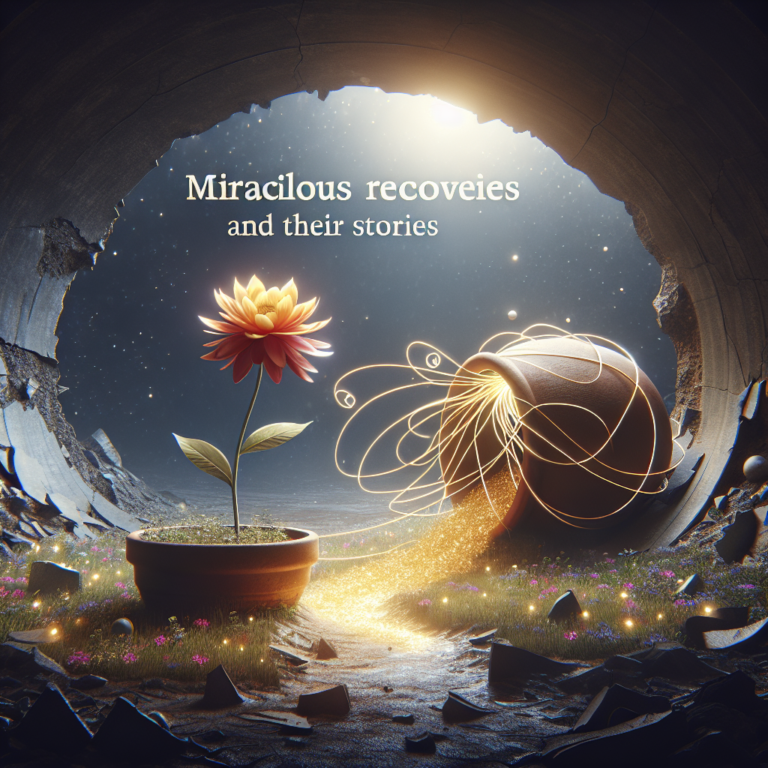What Are Inspiring Tales Of Environmental Activism?
In a world where environmental concerns are increasingly at the forefront of our minds, inspiring tales of environmental activism have the power to ignite a spark within us. From innovative technologies to grassroots movements, these stories showcase the incredible efforts and determination of individuals who are making a difference in tackling various environmental challenges. Each tale serves as a reminder that collective action and passion can truly transform the world we live in. Explore the remarkable stories of these environmental heroes and be inspired to join the movement for a greener future.

The Importance of Environmental Activism
Understanding the urgent need to address environmental issues
In today’s world, environmental issues have become more pressing than ever before. Climate change, deforestation, pollution, and loss of biodiversity are just a few of the challenges that we face. It is crucial for individuals and communities to understand the urgent need to address these environmental issues. Environmental activism plays a vital role in raising awareness about these problems and advocating for solutions.
The role of individuals and communities in environmental conservation
As an individual, you have the power to make a difference in environmental conservation. By making conscious choices in your daily life, such as reducing waste, conserving energy, and using sustainable products, you can contribute to the preservation of our planet. Communities also play a significant role in environmental conservation. When people come together and work towards a common goal, the impact can be tremendous. By organizing clean-up drives, tree-planting initiatives, and awareness campaigns, communities can create a positive change in their surroundings.
How environmental activism can make a significant impact
Environmental activism has the potential to make a significant impact on the state of our planet. By advocating for policy changes, raising public awareness, and promoting sustainable practices, activists can bring about meaningful transformations. Through their efforts, environmental activists not only address specific issues but also inspire others to take action. This domino effect can lead to widespread awareness and positive change on a global scale.
Famous Environmental Activists
Rachel Carson: Pioneering work on environmental conservation
Rachel Carson is widely recognized as one of the pioneers of the modern environmental movement. Her groundbreaking book, “Silent Spring,” published in 1962, highlighted the detrimental effects of pesticide use on the environment and human health. Carson’s work inspired a nationwide ban on the pesticide DDT and brought attention to the need for environmental regulations.
Greta Thunberg: Inspiring youth-led climate strikes worldwide
Greta Thunberg, a Swedish environmental activist, gained international recognition for her solo climate strike outside the Swedish Parliament in 2018. Her movement, Fridays for Future, sparked a global youth-led movement demanding urgent action on climate change. Thunberg’s powerful speeches and passionate activism have motivated millions of young people to stand up and fight for their future.
Wangari Maathai: Founder of the Green Belt Movement in Kenya
Wangari Maathai, a Kenyan environmental activist and Nobel Peace Prize laureate, founded the Green Belt Movement in 1977. The movement aimed to address deforestation and environmental degradation by empowering women to plant trees. Maathai’s efforts not only contributed to reforestation but also promoted women’s empowerment, sustainable agriculture, and community development.
David Suzuki: Prominent Canadian activist and TV personality
David Suzuki, a Canadian environmental activist and scientist, has dedicated his life to raising awareness about environmental issues. Through his television shows, books, and public speaking engagements, Suzuki has educated the public on topics like climate change, biodiversity, and sustainable living. He continues to be an influential voice in advocating for a more sustainable future.
Al Gore: Advocacy for climate change awareness with ‘An Inconvenient Truth’
Former Vice President Al Gore’s documentary, “An Inconvenient Truth,” released in 2006, brought climate change to the forefront of public consciousness. Gore’s efforts to educate the public about the reality of climate change and its impacts have been instrumental in shaping the global conversation on this issue. His advocacy work has inspired individuals and policymakers alike to take action.
Chico Mendes: Fighting for Amazon rainforest and indigenous rights
Chico Mendes was a Brazilian rubber tapper and environmental activist who fought against deforestation and advocated for the rights of indigenous communities in the Amazon rainforest. His work brought international attention to the destructive practices of ranchers and loggers in the region. Tragically, Mendes was assassinated in 1988, but his legacy lives on as a symbol of environmental resistance.
Jane Goodall: Conservation efforts and research on primates
Jane Goodall is a renowned primatologist, conservationist, and anthropologist who has dedicated her life to studying and protecting primates, particularly chimpanzees. Her groundbreaking research at Gombe Stream National Park in Tanzania has shed light on the behavior and intelligence of chimpanzees and has advocated for their conservation. Goodall’s work has inspired countless individuals to take action for the betterment of wildlife and the environment.
Daryl Hannah: Promoting renewable energy and sustainable living
Daryl Hannah, an American actress and environmental activist, has been a passionate advocate for renewable energy and sustainable living. She has been involved in numerous environmental initiatives and has actively promoted the use of solar energy, electric vehicles, and sustainable building practices. Hannah’s dedication to creating a more sustainable world serves as inspiration for individuals and communities alike.
Paul Watson: Co-founder of Greenpeace and Sea Shepherd Society
Paul Watson, a Canadian-American environmental activist and marine conservationist, co-founded both Greenpeace and the Sea Shepherd Conservation Society. Watson’s direct action campaigns and efforts to protect marine life have drawn attention to the impact of commercial whaling, illegal fishing, and environmental destruction. His unwavering commitment to marine conservation has made him a prominent figure in the fight to preserve our oceans.
Winnie Asiti: A local hero protecting wildlife in rural Tanzania
Winnie Asiti is a Tanzanian environmental activist who has been instrumental in protecting wildlife in rural Tanzania. As the executive director of Action for Cheetahs in Kenya and Tanzania, Asiti has worked to mitigate human-wildlife conflicts and promote conservation education. Through her grassroots efforts, Asiti has created positive change in her local community and serves as an inspiring example of the power of individual activism.
Activism Through Innovative Solutions
The Solar Mamas: Empowering women through solar energy
The Solar Mamas program, led by the Barefoot College in India, trains women from rural communities around the world to become solar engineers. These women then return to their villages equipped with the knowledge and skills to install and maintain solar power systems. By empowering women and promoting sustainable energy, the Solar Mamas program has had a transformative impact on communities, improving access to electricity and reducing reliance on fossil fuels.
Dr. Kamal Meattle: Creating a cleaner urban environment with plants
Dr. Kamal Meattle, an environmental activist and researcher in India, promotes the use of indoor plants to improve air quality in urban areas. Through his research, he has identified specific plant species that are highly effective at removing toxins from indoor environments. Meattle’s work has not only resulted in cleaner air but has also led to the creation of indoor green spaces in offices and public buildings.
The Great Green Wall Initiative: Combating desertification in Africa
The Great Green Wall Initiative is a project led by the African Union to combat desertification and land degradation across the Sahel region of Africa. By planting a wall of trees spanning over 8,000 kilometers, the initiative aims to restore degraded land, promote biodiversity, and improve the livelihoods of communities in the region. The Great Green Wall Initiative is a testament to the power of nature-based solutions in tackling environmental challenges.
The Ocean Cleanup: A revolutionary approach to removing ocean plastic
The Ocean Cleanup, founded by Boyan Slat, is an organization dedicated to developing advanced technologies to remove plastic pollution from the world’s oceans. Their innovative system, consisting of floating barriers and autonomous vessels, harnesses ocean currents to collect and concentrate plastic debris for removal. The Ocean Cleanup’s efforts have raised awareness about the urgent need to tackle ocean plastic pollution and have inspired individuals and governments to take action.
Wildlife Conservation Network: On-the-ground conservation efforts
The Wildlife Conservation Network (WCN) is an organization that supports local conservationists and their efforts to protect endangered species and habitats. By providing funding and resources, the WCN enables on-the-ground conservation projects, such as anti-poaching initiatives, habitat restoration, and community outreach programs. The WCN’s model of supporting grassroots conservation efforts has proven to be effective in preserving biodiversity around the world.
Replanting the Mangroves: Restoring vital coastal ecosystems
Mangroves are essential coastal ecosystems that provide numerous ecological benefits, including protecting coastlines from erosion, filtering pollutants, and serving as critical habitats for marine life. Organizations and communities around the world are actively engaged in replanting mangroves to restore these vital ecosystems. By planting mangrove saplings and implementing conservation measures, these efforts contribute to the preservation of coastal biodiversity and the resilience of coastal communities.
Ecovillages: Sustainable communities leading by example
Ecovillages are intentional communities that strive to live in harmony with nature and promote sustainable practices. These communities prioritize renewable energy, organic farming, water conservation, waste reduction, and ecological building techniques. By showcasing alternative ways of living, ecovillages serve as living examples of sustainable lifestyles and inspire others to adopt similar practices in their own communities.
The Greenpeace Ship ‘Rainbow Warrior’: A symbol of peaceful protest
The Greenpeace ship ‘Rainbow Warrior’ is an iconic symbol of peaceful environmental activism. Since its inception in 1978, the ship has been involved in numerous campaigns, including protests against whaling, deforestation, and nuclear testing. The ‘Rainbow Warrior’ represents Greenpeace’s commitment to non-violent direct action and serves as a rallying point for environmental activists around the world.
Reviving Rivers: Restoring damaged river ecosystems
Many rivers around the world have suffered from pollution, damming, and habitat destruction, leading to severe ecological degradation. However, dedicated efforts are being made to restore these damaged river ecosystems. Restoration projects involve removing dams, implementing pollution controls, and restoring natural habitats to allow for the recovery of fish populations, water quality, and overall ecosystem health.
Blue Ventures: Community-led marine conservation in Madagascar
Blue Ventures is an organization that works with coastal communities in Madagascar to promote marine conservation and sustainable fishing practices. By engaging local communities in the management of marine protected areas, Blue Ventures ensures the long-term viability of marine ecosystems and the livelihoods of local fishermen. This community-led approach has resulted in improved fisheries management, increased biodiversity, and enhanced resilience to climate change.
Youth-Led Environmental Activism
Fridays for Future: The global student-led climate movement
Fridays for Future is a global movement started by Greta Thunberg, in which students around the world strike on Fridays to demand urgent action on climate change. Inspired by Thunberg’s activism, young people have taken to the streets, demanding that governments and institutions prioritize climate action and protect their future. The movement has created a sense of urgency and accountability among leaders and has played a crucial role in putting climate change at the top of the political agenda.
Xiuhtezcatl Martinez: Hip hop artist and activist for the planet
Xiuhtezcatl Martinez is a young indigenous hip hop artist and environmental activist who has been speaking out about climate change since a young age. His organization, Earth Guardians, empowers young people to take action on environmental issues and participate in the decision-making process. Martinez’s powerful advocacy through music and public speaking engagements has made him a leading voice in the fight for climate justice.
Autumn Peltier: Advocacy for clean water and indigenous rights
Autumn Peltier, a young indigenous activist from Canada, has been fighting for clean water and indigenous rights since the age of 8. She has been outspoken about the importance of clean water for indigenous communities and has addressed world leaders, including the United Nations, urging them to protect water resources. Peltier’s unwavering dedication to her cause has made her an inspiration to young people around the world.
Isra Hirsi: Co-founder of the U.S. Youth Climate Strike
Isra Hirsi, along with other youth activists, co-founded the U.S. Youth Climate Strike, a movement demanding immediate climate action. Hirsi has been instrumental in mobilizing young people across the United States and organizing climate strikes and protests. Her efforts have helped elevate the voices of young activists and have brought attention to the urgent need for climate justice.
Mari Copeny: Fighting for environmental justice in her community
Mari Copeny, also known as “Little Miss Flint,” gained national attention for her advocacy for clean water in her hometown of Flint, Michigan. Copeny has been a vocal critic of the government’s response to the Flint water crisis and has advocated for environmental justice in marginalized communities. Her resilience and determination have inspired others to speak up and demand access to clean water and a healthy environment.
Vic Barrett: Suing the U.S. government for climate change impacts
Vic Barrett, a young climate activist from the United States, is one of the plaintiffs in the landmark lawsuit Juliana v. United States. The lawsuit seeks to hold the U.S. government accountable for its role in contributing to climate change and its failure to take sufficient action to protect future generations. Barrett’s involvement in the lawsuit highlights the power of young people in demanding climate action and seeking justice for the impacts of climate change.
Alexandria Villaseñor: Raising awareness through climate strikes
Alexandria Villaseñor, a young climate activist from the United States, gained attention for her consistent climate strikes in front of the United Nations headquarters in New York City. Villaseñor’s dedication to raising awareness about the climate crisis and demanding action has made her a prominent voice in the youth-led climate movement. She continues to inspire others to take a stand and push for bold climate solutions.
Maddie Moate: Educating and inspiring children about nature
Maddie Moate is a science communicator and presenter who focuses on educating children about nature and environmental issues. Through her YouTube channel, TV shows, and books, Moate brings scientific concepts to life and encourages young people to explore and protect the natural world. Her engaging approach to science education has made her a role model for young environmentalists.
Lilly Platt: Cleaning up plastic waste and advocating for change
Lilly Platt, an environmental activist from the Netherlands, started picking up litter at the age of 7 and soon became an advocate for cleaning up plastic waste. Platt has organized numerous clean-up events, raised awareness about plastic pollution, and worked with organizations to promote sustainable practices. Despite her young age, Platt’s commitment to protecting the environment has led to tangible changes in her community.
Nadia Nazar: Using art and youth empowerment for environmental action
Nadia Nazar is a young artist and climate activist who uses art as a tool for environmental action. As co-founder of the organization Zero Hour, Nazar has organized youth-led climate marches and engaged young people in creative activism. Through her artwork and activism, she seeks to inspire her generation to become active participants in addressing the climate crisis.
The Power of Indigenous Environmental Activism
Standing Rock Sioux Tribe: Protecting land and water from the Dakota Access Pipeline
The Standing Rock Sioux Tribe’s resistance against the construction of the Dakota Access Pipeline in the United States brought international attention to the rights of indigenous communities and the protection of sacred land and water. The protests sparked a broader conversation about the need to respect indigenous sovereignty and uphold environmental justice. The activism of the Standing Rock Sioux Tribe continues to inspire indigenous communities around the world.
Winona LaDuke: Advocating for indigenous rights and sustainable development
Winona LaDuke, an indigenous environmental activist and leader of the Anishinaabe tribe, has been at the forefront of the fight for indigenous rights and sustainable development. Through her organization, Honor the Earth, LaDuke works to protect indigenous lands, promote renewable energy, and advocate for environmental justice. Her unwavering commitment to indigenous sovereignty and sustainable practices has made her a respected voice in the environmental movement.
Albertina Sisulu: Conservation efforts in South Africa’s indigenous communities
Albertina Sisulu, a prominent anti-apartheid activist in South Africa, also played a crucial role in conservation efforts within indigenous communities. Sisulu’s work focused on promoting sustainable agriculture, protecting natural resources, and empowering rural communities. By recognizing the intimate connection between social justice and environmental conservation, Sisulu’s activism served as a model for holistic development.
Eriel Deranger: Defending the rights of indigenous communities in Canada
Eriel Deranger, a member of the Athabasca Chipewyan First Nation in Canada, is a vocal advocate for indigenous rights, land sovereignty, and climate justice. Deranger has been central in raising awareness about the impacts of tar sands extraction on indigenous lands and communities. Through her work with Indigenous Climate Action, Deranger fights for the recognition and protection of indigenous rights in the context of environmental and climate concerns.
Berta Cáceres: Environmental activism and opposition to hydroelectric projects
Berta Cáceres, a Honduran indigenous leader and environmental activist, dedicated her life to defending indigenous rights and opposing destructive hydroelectric projects. Cáceres co-founded the Council of Indigenous Peoples of Honduras (COPINH) and led successful campaigns against multinational corporations working in indigenous territories. Tragically, Cáceres was assassinated in 2016, but her legacy continues to inspire indigenous and environmental movements worldwide.
Pua Case: Preserving Hawaiian culture and natural resources
Pua Case, a Native Hawaiian activist, has long been involved in efforts to protect Hawaiian culture and natural resources. Case has been vocal in opposing projects that threaten the ecological and cultural integrity of the Hawaiian Islands, such as the construction of the Thirty Meter Telescope on Mauna Kea. Her work amplifies the voices of indigenous peoples and strives for the recognition and protection of indigenous rights and values.
Nemonte Nenquimo: Fighting against oil extraction in the Ecuadorian Amazon
Nemonte Nenquimo, a Waorani indigenous leader from the Ecuadorian Amazon, has been instrumental in opposing oil extraction in indigenous territories. Alongside the Waorani people, Nenquimo led a successful legal battle against the Ecuadorian government and halted oil drilling in the region. Her activism highlights the importance of indigenous communities’ role in protecting their ancestral lands and preserving biodiversity.
Tom Goldtooth: Combating environmental racism and fossil fuel industry
Tom Goldtooth, an indigenous environmental and climate justice activist from the United States, has been a leading voice in the fight against environmental racism and the fossil fuel industry. As executive director of the Indigenous Environmental Network, Goldtooth works to expose the impacts of fossil fuel extraction on indigenous communities and advocates for a just transition to renewable energy. His activism combines advocacy for indigenous rights, environmental justice, and sustainable development.
Phyllis Young: Advancing indigenous sovereignty and environmental justice
Phyllis Young, an indigenous Lakota Sioux activist, has been a prominent advocate for indigenous sovereignty and environmental justice. Young played a vital role in the Standing Rock protests and has been involved in various initiatives promoting renewable energy, indigenous rights, and sustainable development. Young’s activism embodies the intersectionality of indigenous rights, environmental protection, and social justice.
Kandi Mossett: Climate justice and intersectionality in indigenous activism
Kandi Mossett, an indigenous environmental activist from the Mandan, Hidatsa, and Arikara Nation in the United States, focuses on climate justice and the impacts of fossil fuel extraction on indigenous communities. Through her work with the Indigenous Environmental Network, Mossett has been a strong voice against the destructive practices of the fossil fuel industry and has advocated for renewable energy and sustainable alternatives. Her activism highlights the intersectionality of indigenous rights, climate action, and social justice.
Corporate Environmental Activism
Patagonia: A sustainable business model and environmental advocacy
Patagonia, an outdoor clothing company, has become a symbol of corporate environmental activism. The company’s commitment to using recycled materials, reducing its carbon footprint, and supporting environmental initiatives has set a standard for sustainable business practices. Patagonia also uses its platform to advocate for policy changes and raise awareness about environmental issues.
Interface: Pioneering sustainable practices in the carpet industry
Interface, a global carpet manufacturer, is renowned for its pioneering efforts in sustainability. The company prioritizes using recycled materials, reducing emissions, and promoting eco-friendly manufacturing processes. Interface has set ambitious sustainability goals, such as achieving a zero environmental footprint by 2020, and has inspired other companies in the industry to adopt more sustainable practices.
Ben & Jerry’s: Climate justice and social responsibility
Ben & Jerry’s, the well-known ice cream company, has integrated climate justice and social responsibility into its business model. The company sources ingredients from fair trade cooperatives, supports renewable energy initiatives, and advocates for causes such as racial justice and climate action. Ben & Jerry’s has demonstrated that a business can be successful while prioritizing environmental and social issues.
Unilever: Commitment to sustainability across their global operations
Unilever, a multinational consumer goods company, has made sustainability a central focus of its operations. The company aims to reduce its environmental footprint, promote responsible sourcing, and improve the social impact of its products. Unilever’s commitment to sustainability is reflected in its Sustainable Living Plan, which outlines goals and targets for a more sustainable future.
REI: Co-op supporting conservation initiatives and outdoor stewardship
REI, a consumer co-operative specializing in outdoor recreational gear, actively supports conservation initiatives and encourages outdoor stewardship. The company invests in conservation projects, supports non-profit organizations working to protect natural spaces, and promotes responsible outdoor practices through educational programs. REI’s commitment to preserving the environment aligns with its mission to connect people with nature.
Ecosia: A search engine planting trees with ad revenue
Ecosia is a search engine that uses its advertising revenue to fund tree-planting projects around the world. The company transparently reports its financial records and provides updates on the number of trees planted. By using Ecosia as their search engine, individuals can contribute to reforestation efforts and support sustainable initiatives.
Timberland: Environmental responsibility and community service
Timberland, a footwear and clothing company, integrates environmental responsibility and community service into its business practices. The company is committed to reducing its environmental impact, promoting worker well-being, and supporting community initiatives. Timberland’s sustainability efforts include using eco-friendly materials, implementing energy-saving measures, and engaging employees in volunteering activities.
Danone: Promoting sustainable agriculture and circular economy
Danone, a multinational food and beverage company, has made sustainability a core focus of its operations. The company promotes sustainable agriculture, supports smallholder farmers, and invests in circular economy initiatives. Danone’s commitment to responsible production and consumption is reflected in its efforts to reduce waste, improve packaging, and support regenerative agriculture practices.
Levi Strauss & Co.: Efforts to reduce water consumption and promote recycling
Levi Strauss & Co., a global denim company, has implemented various measures to reduce its environmental impact. The company has made significant progress in reducing water consumption, implementing recycling programs, and promoting sustainable business practices throughout its supply chain. Levi Strauss & Co.’s commitment to sustainability demonstrates that large-scale manufacturing can be carried out in an environmentally responsible manner.
Google: Investing in renewable energy and carbon neutrality
Google, a technology company, has set ambitious goals to be carbon-neutral and powered by 100% renewable energy. The company has invested in large-scale renewable energy projects, such as wind and solar farms, to offset its energy consumption. Google’s commitment to clean energy and carbon neutrality underscores the importance of corporate leadership in tackling climate change.
Community-Led Environmental Activism
The Chipko Movement: Hugging trees to prevent deforestation
The Chipko Movement, which originated in the 1970s in Uttarakhand, India, is known for its unique method of environmental activism: hugging trees to prevent deforestation. The movement was led by local communities, particularly women, who took a stand against logging companies. Their peaceful protests and tree-hugging tactics brought attention to the importance of forest conservation and inspired similar movements worldwide.
Transition Initiatives: Community-led responses to peak oil and climate change
Transition Initiatives are grassroots movements that aim to build resilience and sustainability in local communities in response to challenges such as peak oil and climate change. These initiatives focus on community engagement, local food production, renewable energy, and promoting sustainable lifestyles. Transition Initiatives empower communities to take control of their future and transition to a more sustainable way of living.
The Green Belt Movement: Planting trees for environmental restoration
The Green Belt Movement, founded by Wangari Maathai in Kenya, focuses on grassroots tree-planting initiatives to combat deforestation and promote environmental restoration. The movement empowers women in rural communities to plant and care for trees, creating a powerful force for environmental conservation and sustainable development. The Green Belt Movement has had a significant impact on both the environment and the empowerment of women.
350.org: Grassroots climate movement and global campaigns
350.org is an international grassroots movement that aims to address climate change by reducing greenhouse gas emissions to a safe level of 350 parts per million. The organization mobilizes people worldwide through campaigns, education, and direct action to push for effective climate solutions. 350.org has played a crucial role in building a global movement for climate action.
Earthship Biotecture: Sustainable self-sufficient housing solutions
Earthship Biotecture is an architectural and construction movement that promotes sustainable and self-sufficient housing solutions. Earthships are eco-friendly, off-grid homes made from recycled materials and designed to be energy-efficient and environmentally sustainable. The Earthship concept demonstrates that sustainable living is both practical and achievable, inspiring individuals and communities to adopt similar housing solutions.
Casa Pueblo: Energy independence and conservation in Puerto Rico
Casa Pueblo is a community-based organization in Puerto Rico that advocates for energy independence and conservation. After the devastation caused by Hurricane Maria in 2017, Casa Pueblo focused on implementing solar power systems in homes and creating a sustainable energy model for the community. The organization’s efforts have transformed Puerto Rico into a model of energy independence and resilience.
Appalachian Voices: Fighting for clean energy and against mountaintop removal
Appalachian Voices is an organization that advocates for clean energy and against mountaintop removal mining in the Appalachian region of the United States. The organization works to protect the environment, promote sustainable economic development, and ensure the well-being of local communities. Through grassroots organizing and advocacy, Appalachian Voices has been at the forefront of the fight for environmental and social justice in the Appalachian region.
James Balog: Capturing the impact of climate change through photography
James Balog, a renowned photographer and scientist, uses his work to document the impact of climate change on the planet. His photography project, the Extreme Ice Survey, captures time-lapse images of retreating glaciers around the world. Balog’s powerful images bring the reality of climate change to a wider audience and evoke a sense of urgency for action.
Wangaratta Sustainability Network: Engaging the community in environmental action
The Wangaratta Sustainability Network in Australia is a community-led initiative that engages residents in environmental action. The network organizes workshops, events, and projects focused on sustainability, waste reduction, gardening, and energy conservation. By actively involving the community in environmental initiatives, the Wangaratta Sustainability Network fosters a sense of ownership and responsibility towards the environment.
Coral Restoration Foundation: Restoring and protecting coral reefs
The Coral Restoration Foundation is an organization dedicated to the restoration and protection of coral reefs around the world. Through coral farming, outplanting, and education, the foundation works to reverse the decline of coral reef ecosystems. By engaging local communities and promoting sustainable practices, the Coral Restoration Foundation actively contributes to the preservation of marine biodiversity and the health of our oceans.
Art and Media in Environmental Activism
Ai Weiwei: Artistic activism and critiques of environmental policies
Ai Weiwei, a Chinese contemporary artist and activist, uses his art as a medium to raise awareness about social and environmental issues. Through his exhibitions, installations, and sculptures, Ai critiques government policies, advocates for human rights, and sheds light on environmental degradation. His work underscores the power of art as a means of sparking dialogue and promoting change.
Chris Jordan: Photography revealing the consequences of mass consumption
Chris Jordan, a photographer and environmental activist, uses his artwork to portray the consequences of mass consumption and waste generation. His series, such as “Running the Numbers,” features large-scale photographs composed of thousands of individual objects to symbolize the impact of consumerism on the environment. Jordan’s powerful images encourage viewers to reflect on their own consumption habits and inspire conversations about sustainability.
Ricardo Levins Morales: Art as a tool for climate justice
Ricardo Levins Morales, an artist and organizer, uses his art as a tool for climate justice and social change. Through his illustrations and posters, Morales highlights the intersectionality of social issues and advocates for environmental justice. By depicting diverse communities and their struggles, Morales’s art promotes empathy, understanding, and solidarity in the fight for a more just and sustainable world.
Subvertising: Creative subversion of advertisements for environmental issues
Subvertising refers to the practice of creatively subverting advertisements to convey alternative messages, often related to environmental issues and consumerism. Artists and activists use various techniques, such as replacing billboard images with thought-provoking statements or altering brand logos to critique the negative impact of corporate practices. Subvertising challenges the dominance of advertising in public spaces and invites critical thinking about our consumer culture.
The Story of Stuff Project: Using media to promote sustainability
The Story of Stuff Project is a nonprofit organization that uses videos, podcasts, and educational materials to raise awareness about the social and environmental impacts of consumption. Through engaging storytelling, the project explores the life cycle of consumer goods, from extraction to disposal, and promotes sustainable alternatives. The Story of Stuff Project empowers individuals to make informed choices and advocate for systemic change.
Banksy: Street art highlighting environmental degradation and capitalist culture
Banksy, a pseudonymous street artist, is known for his politically charged and thought-provoking artworks. His murals often address environmental degradation, capitalist culture, and the impacts of technology on society. Banksy’s art challenges prevailing norms and sparks conversations about social and environmental justice, making a lasting impact on public consciousness.
The Yes Men: Satirical activism and media interventions
The Yes Men are a culture jamming activist duo that use humor and satire to expose corporate greed and political inaction on environmental issues. Through media interventions, such as impersonating corporate representatives or staging elaborate pranks, The Yes Men highlight the absurdity of certain practices and advocate for more sustainable and equitable solutions. Their creative approach aims to provoke discussion and prompt societal change.
Black Rock Solar: Bringing renewable energy to tribal communities
Black Rock Solar is a nonprofit organization that provides solar power installations to underserved communities, particularly Native American tribes in the United States. By collaborating with tribal governments, Black Rock Solar has helped tribes transition to renewable energy, reduce reliance on fossil fuels, and improve access to electricity. Through their work, the organization fosters sustainable development, energy independence, and community empowerment.
Rebecca Hosking: Filmmaking and storytelling for sustainable agriculture
Rebecca Hosking, a British filmmaker and environmentalist, has used her documentaries and storytelling to promote sustainable agriculture and rural communities. Her film, “A Farm for the Future,” explores regenerative farming practices and their potential to mitigate climate change. Hosking’s storytelling and advocacy encourage viewers to rethink our relationship with food and embrace more sustainable agricultural practices.
The Canary Project: Art exhibitions addressing climate change and ecological crises
The Canary Project is an art collaborative that utilizes photography, installations, and exhibitions to explore the consequences of climate change and ecological crises. Through their work, the project seeks to communicate the urgency and severity of these issues and inspire action. The Canary Project’s interdisciplinary approach bridges the gap between art and science, fostering a deeper understanding of the environmental challenges we face.
Legislation and Policy Changes
The Paris Agreement: Uniting nations against climate change
The Paris Agreement, signed in 2015, is a landmark international agreement that commits countries to limit global warming and address climate change. It sets the goal of keeping global temperature rise well below 2 degrees Celsius above pre-industrial levels. By fostering global cooperation and requiring countries to regularly report and review their progress, the Paris Agreement provides a framework for collective action in combating climate change.
Montreal Protocol: Global action to protect the ozone layer
The Montreal Protocol, established in 1987, aims to protect the Earth’s ozone layer by phasing out the production and use of ozone-depleting substances. The protocol has been widely hailed as one of the most successful environmental agreements, leading to a significant reduction in the production of substances such as chlorofluorocarbons (CFCs) and the restoration of the ozone layer. The Montreal Protocol exemplifies the power of international cooperation in addressing global environmental challenges.
The Clean Air Act: Reducing air pollution and promoting public health
The Clean Air Act, implemented in many countries around the world, sets standards and regulations to reduce air pollution and protect public health. The act targets pollutants such as sulfur dioxide, nitrogen oxides, particulate matter, and greenhouse gases. Through emissions controls, vehicle regulations, and other measures, the Clean Air Act has contributed to improved air quality and reduced the impacts of pollution on human health and the environment.
The Endangered Species Act: Protecting biodiversity and endangered wildlife
The Endangered Species Act, enacted in the United States in 1973, provides legal protection for endangered and threatened species and their habitats. The act requires the identification and designation of critical habitats, the development of recovery plans, and the implementation of conservation measures. The Endangered Species Act has played a crucial role in preserving biodiversity and preventing the extinction of iconic species.
CITES: Regulating international trade in endangered species
The Convention on International Trade in Endangered Species of Wild Fauna and Flora (CITES) is an international agreement that regulates the trade of endangered species. CITES ensures that international trade in wildlife does not threaten the survival of species and promotes sustainable use of natural resources. Through its regulations and monitoring mechanisms, CITES aims to combat illegal wildlife trade and protect endangered species worldwide.
Plastic Bans and Reduction Initiatives: Tackling plastic waste from legislation
Plastic bans and reduction initiatives have become increasingly common worldwide as a response to the growing problem of plastic pollution. These measures include bans on single-use plastic items, restrictions on plastic packaging, and the imposition of levies or taxes on plastic products. By reducing plastic waste, encouraging recycling, and promoting alternative materials, these initiatives are crucial in addressing the environmental impacts of plastic pollution.
Renewable Energy Standards: Promoting clean energy adoption through policies
Renewable energy standards, also known as renewable portfolio standards, require utilities to obtain a certain percentage of their energy from renewable sources. These policy mechanisms incentivize the adoption of clean energy technologies, such as solar and wind power, by setting targets and establishing frameworks for renewable energy development. Renewable energy standards have been instrumental in accelerating the transition to a low-carbon energy system.
Carbon Pricing: Economic incentives to reduce greenhouse gas emissions
Carbon pricing mechanisms, such as carbon taxes and cap-and-trade systems, put a price on greenhouse gas emissions and create economic incentives for industries to reduce their carbon footprint. By internalizing the costs of carbon pollution, carbon pricing aims to stimulate investment in low-carbon technologies and encourage emission reductions. Carbon pricing has gained traction as an effective policy tool in mitigating climate change and facilitating the transition to a low-carbon economy.
Water Protection Legislation: Safeguarding freshwater resources
Water protection legislation aims to safeguard freshwater resources, ensure clean drinking water, and promote responsible water management. These laws regulate activities such as industrial wastewater discharge, agricultural runoff, and water use rights. Water protection legislation sets standards for water quality and establishes frameworks for water resource management, contributing to the sustainable use and conservation of freshwater ecosystems.
Land Conservation and National Park Designations: Preserving natural habitats
Land conservation and the designation of national parks and protected areas are essential for preserving natural habitats and biodiversity. These initiatives involve setting aside land for conservation purposes, restricting development activities, and promoting responsible land stewardship. Conservation efforts aim to protect ecosystems, safeguard endangered species, and provide recreational opportunities while ensuring the long-term sustainability of natural resources.
International Environmental Cooperation
Intergovernmental Panel on Climate Change (IPCC): Assessing scientific knowledge
The Intergovernmental Panel on Climate Change (IPCC) is an international body responsible for assessing the scientific, technical, and socio-economic aspects of climate change. The IPCC’s reports provide policymakers with a comprehensive understanding of the current state of climate science, impacts, and potential mitigation and adaptation strategies. The work of the IPCC informs decision-making and policy development at both national and international levels.
United Nations Environment Programme (UNEP): Promoting sustainable development
The United Nations Environment Programme (UNEP) is the leading global authority on environmental issues. UNEP coordinates international efforts to address environmental challenges, promotes sustainable development, and supports countries in implementing environmental policies. Through its scientific research, capacity-building initiatives, and advocacy work, UNEP plays a critical role in fostering international cooperation and guiding policy decisions.
The Global Climate Action Summit: Collaborative efforts towards climate goals
The Global Climate Action Summit is a global event that brings together leaders from government, business, and civil society to showcase climate action and generate momentum towards achieving the goals of the Paris Agreement. The summit provides a platform for showcasing ambitious commitments, sharing best practices, and catalyzing collaborative efforts to address climate change. By fostering dialogue and collaboration, the summit contributes to the advancement of global climate goals.
COP26: United Nations climate conference for global action
COP26, the 26th United Nations Climate Change Conference of the Parties, provides a forum for global negotiations on climate change mitigation, adaptation, and finance. The conference brings together world leaders, policymakers, and stakeholders to make decisions and agreements on climate action. COP26 plays a critical role in advancing international cooperation and commitment to address climate change.
United Nations Framework Convention on Climate Change (UNFCCC): International climate negotiations
The United Nations Framework Convention on Climate Change (UNFCCC) is an international treaty that provides the framework for global efforts to combat climate change. The convention aims to stabilize greenhouse gas concentrations in the atmosphere and prevent dangerous human interference with the climate system. The UNFCCC facilitates international climate negotiations, including the annual Conference of the Parties (COP), where countries come together to discuss and coordinate climate action.
The Green Climate Fund: Supporting climate adaptation and mitigation projects
The Green Climate Fund (GCF) is a financial mechanism established to support developing countries in their efforts to address climate change. The fund provides financial resources for climate adaptation projects, mitigation initiatives, and capacity-building activities, particularly in the most vulnerable regions. The GCF plays a crucial role in mobilizing climate finance and supporting sustainable development in developing countries.
Convention on Biological Diversity (CBD): Conserving biodiversity worldwide
The Convention on Biological Diversity (CBD) is an international agreement that aims to promote the conservation and sustainable use of biodiversity. Through its objectives, the CBD addresses issues such as habitat loss, species extinction, and the fair and equitable sharing of benefits from genetic resources. The CBD provides a framework for international cooperation, environmental governance, and the protection of Earth’s rich biodiversity.
World Wildlife Fund (WWF): Conservation efforts and ecological research
The World Wildlife Fund (WWF) is a leading conservation organization that works to protect species and their habitats, promote sustainable development, and address global environmental issues. The WWF undertakes scientific research, engages in policy advocacy, and implements on-the-ground conservation projects around the world. Through its work, the WWF aims to ensure a harmonious relationship between people and nature.
Global Environmental Facility (GEF): Funding projects for sustainable development
The Global Environmental Facility (GEF) is an international financial institution that supports projects and initiatives addressing global environmental challenges. The GEF provides grants and funding for projects related to biodiversity conservation, climate change mitigation and adaptation, land degradation, and sustainable development. By mobilizing resources and promoting collaboration, the GEF plays a critical role in advancing sustainable development goals worldwide.
United Nations Sustainable Development Goals (SDGs): 17 goals for a sustainable future
The United Nations Sustainable Development Goals (SDGs) are a set of 17 goals that aim to address the world’s most pressing social, economic, and environmental challenges. The goals, which include targets related to poverty reduction, climate action, clean energy, and sustainable consumption, provide a framework for international cooperation and action. The SDGs underscore the interconnectedness of environmental, social, and economic issues and guide efforts towards a more sustainable future.
In conclusion, environmental activism is of paramount importance in addressing the urgent need for environmental conservation. From famous activists who have made their mark in history to innovative solutions being implemented on the ground, youth-led movements, indigenous environmental activism, and corporate and community efforts, all contribute to a collective struggle to protect our planet. Legislative and policy changes along with international cooperation also play a crucial role in addressing environmental challenges. By working together and taking action, we can create a sustainable future for generations to come.







